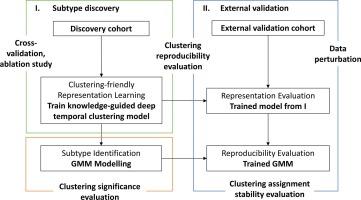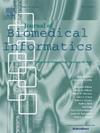Clinical outcome-guided deep temporal clustering for disease progression subtyping
IF 4
2区 医学
Q2 COMPUTER SCIENCE, INTERDISCIPLINARY APPLICATIONS
引用次数: 0
Abstract
Objective
Complex diseases exhibit heterogeneous progression patterns, necessitating effective capture and clustering of longitudinal changes to identify disease subtypes for personalized treatments. However, existing studies often fail to design clustering-specific representations or neglect clinical outcomes, thereby limiting the interpretability and clinical utility.
Method
We design a unified framework for subtyping longitudinal progressive diseases. We focus on effectively integrating all data from disease progressions and improving patient representation for downstream clustering. Specifically, we propose a clinical Outcome-Guided Deep Temporal Clustering (OG-DTC) that generates representations informed by clustering and clinical outcomes. A GRU-based seq2seq architecture captures the temporal dynamics, and the model integrates k-means clustering and outcome regression to facilitate the formation of clustering structures and the integration of clinical outcomes. The learned representations are clustered using a Gaussian mixture model to identify distinct subtypes. The clustering results are extensively validated through reproducibility, stability, and significance tests.
Results
We demonstrated the efficacy of our framework by applying it to three Alzheimer’s Disease (AD) clinical trials. Through the AD case study, we identified three distinct subtypes with unique patterns associated with differentiated clinical declines across multiple measures. The ablation study revealed the contributions of each component in the model and showed that jointly optimizing the full model improved patient representations for clustering. Extensive validations showed that the derived clustering is reproducible, stable, and significant.
Conclusion
Our temporal clustering framework can derive robust clustering applicable for subtyping longitudinal progressive diseases and has the potential to account for subtype variability in clinical outcomes.

临床结果指导下的疾病进展亚型深度时间聚类。
目的:复杂疾病的发展模式各不相同,因此需要有效捕捉和聚类纵向变化,以确定疾病亚型,从而进行个性化治疗。然而,现有的研究往往未能设计出针对特定聚类的表征,或忽略了临床结果,从而限制了研究的可解释性和临床实用性:方法:我们设计了一个统一的框架,用于对纵向进展性疾病进行亚型分析。我们的重点是有效整合疾病进展的所有数据,并为下游聚类改进患者表示。具体来说,我们提出了一种临床结果引导的深度时空聚类(OG-DTC),它能根据聚类和临床结果生成表征。基于 GRU 的 seq2seq 架构可捕捉时间动态,该模型整合了 k-means 聚类和结果回归,以促进聚类结构的形成和临床结果的整合。利用高斯混合模型对学习到的表征进行聚类,以识别不同的亚型。聚类结果通过可重复性、稳定性和显著性测试进行了广泛验证:我们将该框架应用于三项阿尔茨海默病(AD)临床试验,证明了它的功效。通过阿尔茨海默病病例研究,我们发现了三种不同的亚型,它们具有独特的模式,与多种测量指标下不同的临床衰退相关联。消融研究揭示了模型中每个组成部分的贡献,并表明联合优化完整模型可改善患者聚类的代表性。广泛的验证表明,得出的聚类具有可重复性、稳定性和显著性:我们的时间聚类框架可以推导出适用于纵向进展性疾病亚型的稳健聚类,并有可能解释临床结果中的亚型变异。
本文章由计算机程序翻译,如有差异,请以英文原文为准。
求助全文
约1分钟内获得全文
求助全文
来源期刊

Journal of Biomedical Informatics
医学-计算机:跨学科应用
CiteScore
8.90
自引率
6.70%
发文量
243
审稿时长
32 days
期刊介绍:
The Journal of Biomedical Informatics reflects a commitment to high-quality original research papers, reviews, and commentaries in the area of biomedical informatics methodology. Although we publish articles motivated by applications in the biomedical sciences (for example, clinical medicine, health care, population health, and translational bioinformatics), the journal emphasizes reports of new methodologies and techniques that have general applicability and that form the basis for the evolving science of biomedical informatics. Articles on medical devices; evaluations of implemented systems (including clinical trials of information technologies); or papers that provide insight into a biological process, a specific disease, or treatment options would generally be more suitable for publication in other venues. Papers on applications of signal processing and image analysis are often more suitable for biomedical engineering journals or other informatics journals, although we do publish papers that emphasize the information management and knowledge representation/modeling issues that arise in the storage and use of biological signals and images. System descriptions are welcome if they illustrate and substantiate the underlying methodology that is the principal focus of the report and an effort is made to address the generalizability and/or range of application of that methodology. Note also that, given the international nature of JBI, papers that deal with specific languages other than English, or with country-specific health systems or approaches, are acceptable for JBI only if they offer generalizable lessons that are relevant to the broad JBI readership, regardless of their country, language, culture, or health system.
 求助内容:
求助内容: 应助结果提醒方式:
应助结果提醒方式:


